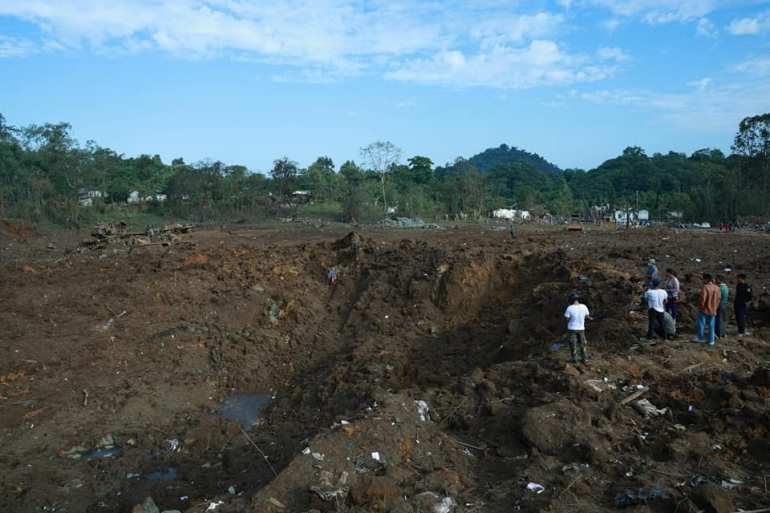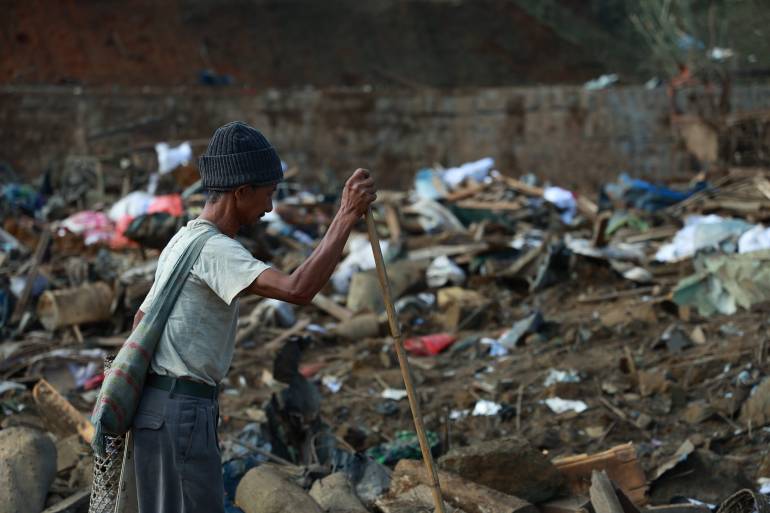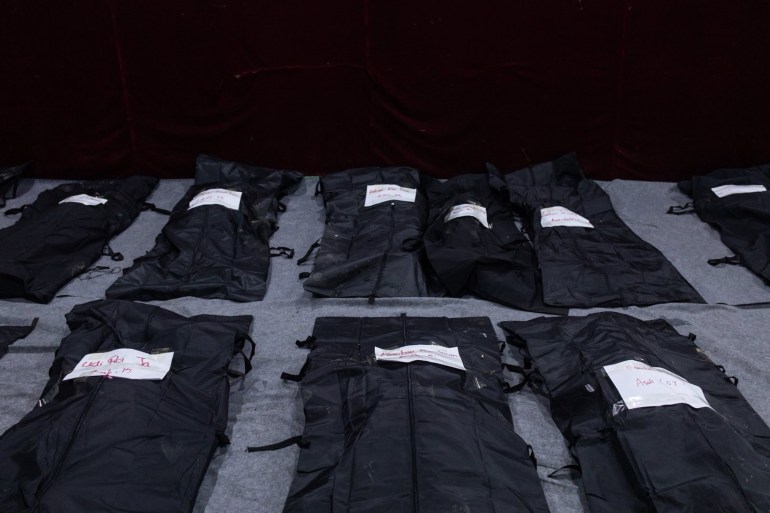On the evening of October 9, Seng Mai was awoken by a deafening explosion that tore aside her shelter in Mung Lai Hkyet, a camp for conflict-displaced folks in northern Myanmar’s Kachin State.
“The sound was so loud that I questioned whether or not I had even survived,” the 21-year-old instructed Al Jazeera.
As rounds of mortar fireplace thundered from the course of a close-by army put up, she crawled right into a makeshift trench.
“A grandmother was crying and shouting for assist. My mom was operating barefoot,” she mentioned. “Youngsters have been additionally operating at the hours of darkness, struggling to succeed in a protected place.”
By the point the bombardment was over, 28 civilians together with 12 kids had been killed and dozens of shelters in addition to a kindergarten and church have been destroyed. Rights teams have blamed the army, which seized energy from the elected authorities of Aung San Suu Kyi in February 2021 and has thus far denied duty for the assault.
It has an intensive report of concentrating on civilians and civilian areas, nonetheless, and its actions have solely change into “more and more brazen” because the coup, in keeping with a United Nations-appointed investigative mechanism. In August, the mechanism introduced that it had discovered “compelling proof” that the army had dedicated “extra frequent and audacious war crimes and crimes in opposition to humanity”.
Bolstering this declare, a report revealed by the UN’s human rights workplace final month discovered that the army had killed a minimum of 3,800 civilians, destroyed almost 75,000 civilian properties and performed almost 1,000 air strikes within the greater than two and a half years because the coup.
“Emboldened by confidence in impunity, army actions have grown in depth and brutality,” mentioned the report. “A seemingly limitless spiral of army violence has engulfed all points of life in Myanmar.”
The current assault on Mung Lai Hkyet focused civilians displaced by conflict since 2011.
A number of Kachin internally displaced youth, three of whom witnessed the Mung Lai Hkyet assault, instructed Al Jazeera the incident had left them traumatised and afraid. It additionally bolstered their sense that that they had nowhere protected to run.
“I need to sleep at evening however I can’t as a result of I preserve recalling the assault. I really feel fearful and anxious about what may occur, whereas additionally recalling the horrible and tragic experiences that I’ve been by means of,” mentioned Seng Mai, who has lived in Mung Lai Hkyet since 2011. “Since I grew to become an IDP [internally displaced person], there have been many lengthy and sleepless nights.”
Al Jazeera has given Seng Mai and others interviewed pseudonyms as a result of danger of army retaliation.
‘No protected place’
Like many ethnic minorities in Myanmar, Kachin folks have been targets of the army’s human rights abuses lengthy earlier than the coup. The Kachin Independence Organisation (KIO), one among greater than a dozen ethnic armed teams alongside the nation’s borders, started its battle for autonomy in 1961 and ever since, the army has tried to chop its entry to meals, funds, intelligence and recruits in a technique generally known as “four cuts.”
The strategy, which particularly targets civilians, has solely added gas to the Kachin resistance, which entered a brand new section with the collapse of a 17-year-long ceasefire in 2011. The preventing that adopted displaced some 100,000 folks, most of whom fled to camps. With the army criminalising affiliation with or help to the KIO below its Illegal Associations Act, greater than a 3rd took refuge in KIO territory alongside Myanmar’s japanese border with China.
Htu Uncooked, who’s utilizing a pseudonym, recalled listening to the preventing get away from the state capital of Myitkyina, the place she was boarding on the time to attend highschool. Her household quickly fled their village however she solely came upon two years later when she completed college and her mom got here to select her up.
“I observed that the journey again wasn’t the identical,” Htu Uncooked mentioned. “I requested her the place we have been going, and she or he replied, ‘We now have change into IDPs now and we’re going again to the camp’.” Referred to as Woi Chyai, it’s subsequent to Mung Lai Hkyet and about 5km (3.1 miles) north of the KIO’s headquarters in Laiza.

It was only some years earlier than preventing broke out once more, prompting the camps’ residents to dig trenches the place they might conceal. “There have been many instances after we needed to dig trenches and run into them after we heard the sound of planes,” mentioned Htu Uncooked.
In 2019, the Aung San Suu Kyi-led civilian authorities started discussions with Kachin civil society in regards to the return of displaced folks to their villages as a part of a broader effort to shut IDP camps throughout the nation. The initiative, nonetheless, was largely rejected by Kachin IDPs themselves as a result of lack of a ceasefire between the KIO and the army, or any safety assure for individuals who returned.
Nonetheless, many realised that the camps may present them with little safety.
“Because the conflict resumed in 2011, the whole Laiza space hasn’t been a protected place for us to remain however we don’t produce other protected locations to go,” mentioned Ah Hpung, a youth chief in Woi Chyai camp.
Traumatised folks
After the coup, Kachin IDPs grew to become much more susceptible as safety circumstances deteriorated throughout the nation. Inside months, the army had killed a whole bunch of nonviolent protesters, scary widespread armed resistance to its rule. The KIO has been energetic in offering coaching and weapons to newer resistance teams, whereas additionally clashing often with army forces.
In current months, the preventing has more and more neared Laiza, and though the residents of Mung Lai Hkyet had been on alert, the assault on October 9 got here with out warning. “Usually, we hear artillery shelling and jets flying, and we run and conceal within the trenches for a second, however on this case, we didn’t hear any planes,” mentioned Seng Mai.
In line with Ah Hpung, the assault has instilled a brand new stage of worry among the many displaced. “Because the conflict resumed, bombs have often fallen close to us, however we felt we may conceal in trenches throughout these instances,” he mentioned. “Now, those that have been affected in the course of the current assault don’t dare to return. We all the time really feel unsafe in our homeland.”
He and others additionally described a neighborhood deeply traumatised by the incident. “Some kids misplaced their moms. They didn’t communicate in any respect and simply stared,” mentioned Ah Hpung. “A number of the kids who heard the sound of the bomb and witnessed the size of the harm are dropping their minds.”

Htu Uncooked, who hid in a bunker in Woi Chyai camp in the course of the assault after which rushed to assist the wounded, has been unable to sleep. “Once I hear the sound of a falling object, I instantly suppose it may very well be a bomb,” she mentioned. “I’m even scared when darkness falls.”
Having misplaced their houses and belongings, those that survived are additionally prone to face important monetary hardships, exacerbating the difficulties they already confronted as a result of pandemic and coup. “There are various livelihood difficulties in each IDP household,” mentioned Ah Ngwar Mee, whose 9 relations survived the assault. “As a result of we keep in camps the place we don’t personal the land, it’s tough even to backyard.”
In line with Htu Uncooked, who put aside her research when she was 19 to work, many younger folks have been already struggling simply to attend college.“Many IDP youth need to proceed their training. Some are very enthusiastic about turning into educated however as a result of their households usually are not in a position to help them, they need to let go of their desires,” she mentioned.
Ah Hpung fears that the Mung Lai Hkyet assault is prone to put college students’ instructional objectives again even additional. “Now, the youth really feel hopeless and depressed in regards to the future,” he mentioned.
Hatred deepens
Along with the hardships inflicted by the assault, it has solely deepened the survivors’ hatred of the army. “This needs to be remembered so long as we reside and we should always go it all the way down to the following technology,” mentioned Ah Hpung. “It exhibits the brutality of the Burmese [military] and that we should always by no means ally or be a part of with them.”
For a lot of Kachin folks, the assault additionally feeds into a way of persecution that has solely elevated because the coup, particularly after the army bombed a music concert close to the jade mining city of Hpakant final October, leaving dozens of individuals lifeless. “They’re deliberately killing our folks and insulting us,” mentioned Sut Seng Htoi, a distinguished Kachin activist who was displaced in 2017. “They’re attempting to indicate that they will kill us wherever.”
She instructed Al Jazeera that she want to see Kachin folks in Myanmar and all over the world double down of their efforts to withstand army rule and promote the event of robust and wholesome Kachin establishments. “We, Kachin folks, must refocus on our unity and aspirations,” she mentioned. “The sensation of loving our folks shouldn’t be sufficient; there should be motion.”
Within the week because the assault, Kachins and different Myanmar nationals all over the world have labored to lift worldwide consciousness in regards to the incident and advocate for a stronger response, together with sanctions on aviation gas which the army makes use of to bomb civilians. In Chiang Mai, Thailand, a gaggle of activists held a theatrical re-enactment of the incident, and in Bangkok, a gaggle of protesters stood in entrance of the United Nations workplace with indicators calling on the organisation to “finish its circle of failures in Myanmar”.

Others are elevating funds, together with a gaggle of Kachin college students and migrant employees in Tel Aviv, Israel who’ve pooled their cash to ship to the Mung Lai Hkyet survivors whilst they conceal in bunkers themselves.
Sarah Nu, a Kachin youth who has been dwelling in Tel Aviv since 2018, mentioned she want to see Western international locations and support organisations provide Myanmar’s democracy motion and the Kachin battle for self-determination the form of consideration and help that they’ve proven to Israel.
“Israel is already a developed nation and the United States and Western international locations have supported it effectively. Relating to Kachin state and Kachin folks, there isn’t a lot help,” she mentioned. “There’s an enormous distinction in terms of helping the folks.”
Again within the camp, Ah Hpung known as on Kachins and others all over the world to maintain their consideration on the disaster in Myanmar, together with by selling a greater future for internally displaced youth. “At any time when there’s conflict, we, the youth, need to endure from it,” he mentioned. “We have to help the youth who’re supporting our folks.”
